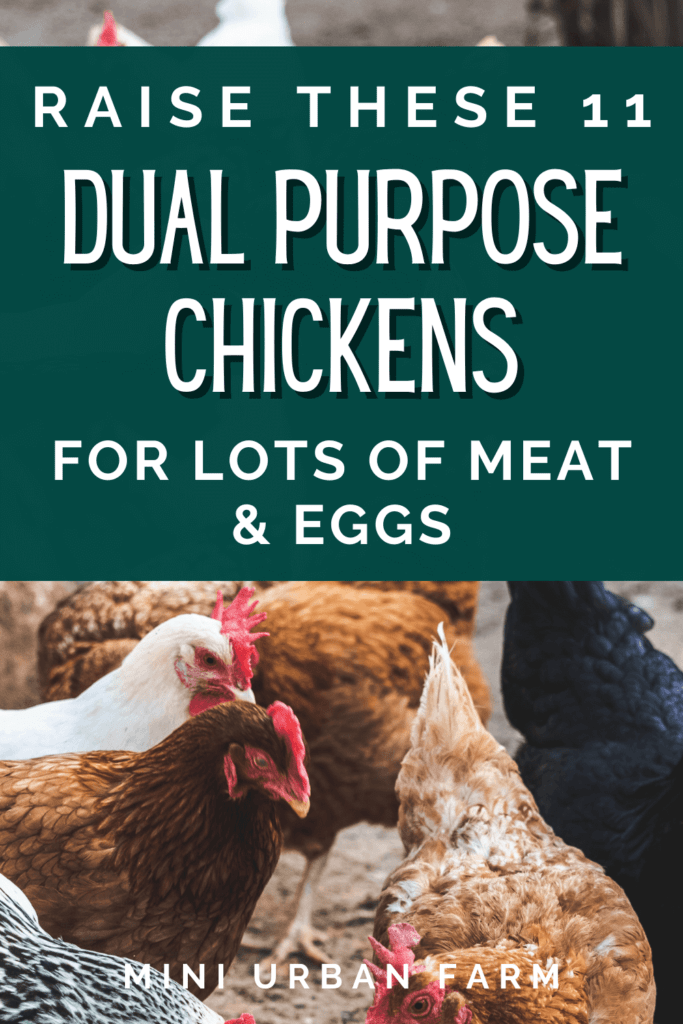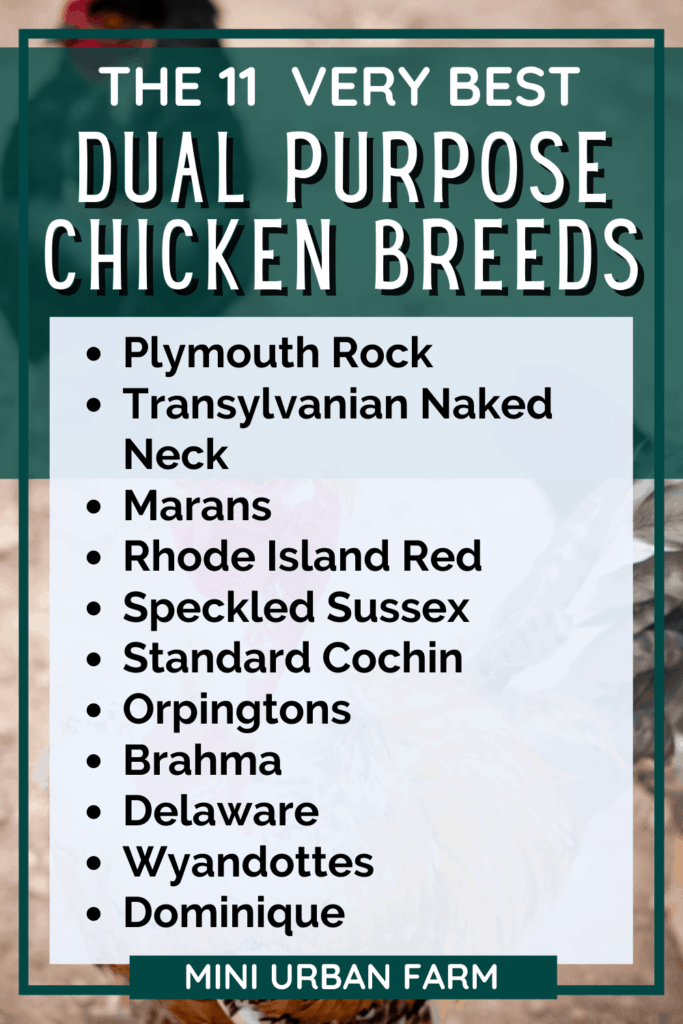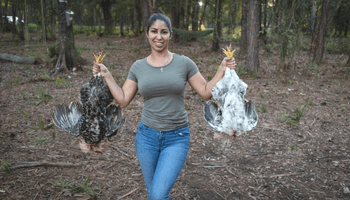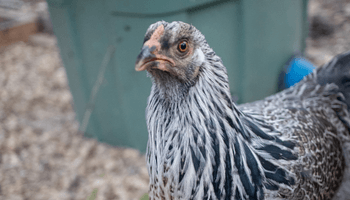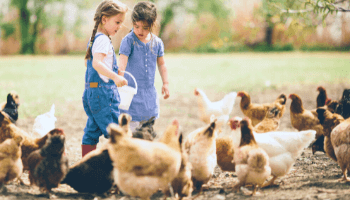If you’re just getting into the chicken keeping game, there are some chickens that are raised only for eggs, some that are raised solely to provide meat, and then there are those dual-purpose chicken breeds that will give you both meat and eggs! In my experience, these are the best types of chickens.
Now, I raise Plymouth Barred Rock for meat and eggs, but I have a bunch of other chicken breeds in my flock, solely for eggs. And there are many breeds of chickens that will provide you with both. Here are the best ones!
Best Dual-Purpose Chicken Breeds:
- Plymouth Rock
- Transylvanian Naked Neck
- Marans
- Rhode Island Red
- Speckled Sussex
- Standard Cochin
- Orpingtons
- Brahma
- Delaware
- Wyandottes
- Dominique
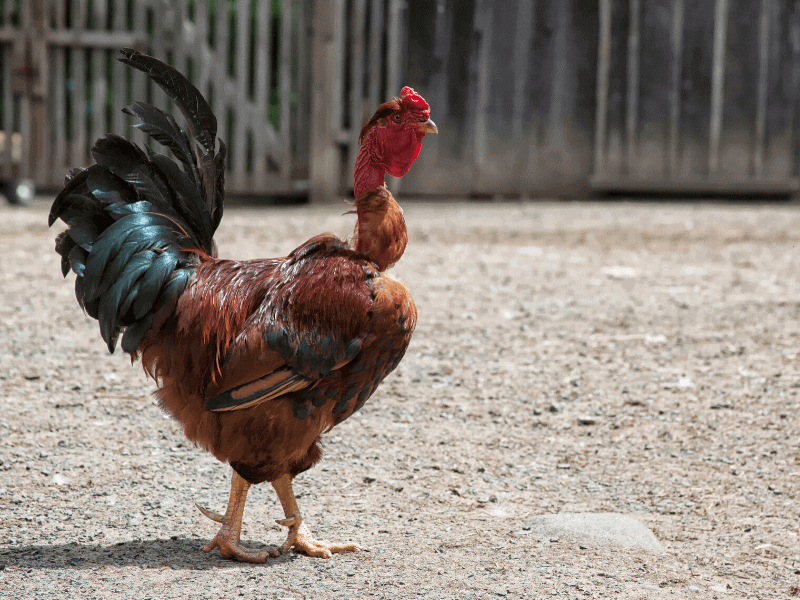
Disclosure: This post may contain affiliate links. If you purchase a product through one of our affiliate links we make a small commission from the sale at no extra cost to our readers.
WHAT IS A DUAL PURPOSE CHICKEN BREED?
I’m glad you asked.
A dual-purpose chicken breed is a chicken breed that has the benefit of producing good-quality meat for the table, but also lays a high number of eggs.
Typically, a “meat chicken” is a commercial hybrid bird that gains weight quickly and produces an extremely large bird.
It’s important to note that while meat birds might seem like a great option, they are not going to be sustainable since they will not naturally reproduce into baby meat birds.
They also grow very quickly and their bodies usually can’t keep up – which means they spend much of their life just sitting next to the feeder and eating.
Egg layers on the other hand, are chicken breeds that lay lots of eggs and do not normally get as heavy as other breeds. You wouldn’t want to butcher these birds since you’ll not get a good return for your efforts.
Straight down the middle are your dual-purpose chickens.
These birds will give you just as many eggs as egg layers, but get much heavier than those breeds.
Dual purpose birds will not grow as fast or get as large as “meat birds.” But they are sustainable and healthy birds.
1) PLYMOUTH BARRED ROCK
All our meat chickens are Plymouth Barred Rocks, so I’m naturally biased to this breed.
Plymouth Rocks are actually one of the oldest chicken breeds in the US, and are a great heritage breed for both meat and eggs.
There are seven varieties of the Plymouth Rock breeds, but apart from the white and the barred ones, all others are pretty rare.
Plymouth Rocks have excellent egg and meat production, and I often have way more eggs than I can ever use! Which means I’ve had to come up with some very creative ways to use up those eggs!
A Plymouth Rock lays about 200 eggs per year, which translates to 1 egg, every 2 days on average. Their eggs are medium-large and have a light brown to tan color.
Plus they are heavy birds, weighing 7 to 8lb for the male and 6lbs for the female, which makes them good for the table! Ours actually dressed out even larger than that!
They are also pretty friendly – they come up to me and let me pet them, you know – when they feel like it!
I will say though, that the Plymouth Barred Rock roosters can become quite aggressive with the females. But when I separated them out, the roosters got along pretty well.
2) TRANSYLVANIAN NAKED NECK
If you’ve never heard of this breed, you’re in for a treat.
Imagine a cross between a turkey and a chicken – that’s what a Naked Neck looks like!
Of course, this dual-purpose breed (which is sometimes referred to as a Turken) is actually not a cross between turkeys and chickens – they are just a type of chicken with less feathers (and no feathers on their seemingly elongated neck.)
People tend to either love Naked Necks, or hate them. Mostly because they are ugly.
I happen to fall into the “it’s so ugly it’s actually cute category.”
But there’s one thing that makes Naked Necks such a great dual purpose bird.
Yes, they lay a good amount of large brown eggs.
And yes, they are a pretty decent sized bird.
But the one thing that really stands out for meat production is that they have way less feathers overall.
This makes plucking them so much easier!
And if you’ve ever butchered a chicken, you know that cutting through feathers is the easiest way to dull your blade!
Plus, they do really well in the heat – perfect for Central Florida where I homestead!
So last week when the salesman at the feed store offered me some free baby Naked Necks (8 of them to be exact) I jumped at the opportunity!
Now we are the proud owners (well, I’m the proud owner – Alan hates them!) of 8 teeny tiny Naked Neck chickens! And we’ll be incorporating them into our meat chicken program as soon as they reach maturity!
3) MARANS
Marans come in several varieties and are deemed friendly birds that can be kept for meat or eggs.
The roosters can weigh up to 8 lbs while the hens can weigh up to 6.5 lb, which makes them a pretty decent sized bird for the table.
They lay about 150-200 large eggs a year and they also rarely ever go broody. Some never go broody at all in their lifetime.
This breed is winter-hardy and can withstand pretty cold weather, they are not too keen on the hot weather.
Marans are excellent free rangers but also deal well with confinement. They’re friendly, calm, and intelligent, which makes them good for first-time chicken keepers.
Plus, they lay beautiful chocolate colored eggs – which if you’re looking for some variety in your coop, is a must have breed!
4) RHODE ISLAND RED
I previously had a Rhode Island Red rooster called Nugget – and man was he pretty!
Rhode Island Red chickens are easy to take care of, and pretty docile over all.
They are excellent layers, laying 5-6 eggs in a week, or up to 300 eggs per year! Their eggs are light brown and their size ranges from medium to large.
The best thing about Rhode Island Reds is that they start laying as early as 16 weeks, and the older they grow the bigger the size of their eggs becomes.
Male Rhode Island Reds weigh about 8 lbs while the hens weigh around 6 lbs. This makes them heavy enough for the table!
5) SPECKLED SUSSEX
We keep a Speckled Sussex in our flock named Cookies and Cream. She’s absolutely beautiful and is one of the largest hens in my flock.
The Speckled Sussex breed is overall very friendly, though the roosters do have the tendency to become more protective of their flock.
And they are a heritage chicken breed, so they are a tried and true breed!
Hens can lay approximately 250 large cream colored eggs per year, and this breed has even been known throughout the coldest winter months!
Speckled Sussex roosters weigh in at about 9 lbs while the hens come in around 7 ish lbs, which makes them ideal for meat too.
This breed does have the reputation of going broody, though. And Cookies and Cream was no exception!
6) STANDARD COCHIN
Cochins are fluffy and beautiful birds that tend to be on the friendlier side. They have feathers all down their legs and are definitely interesting looking!
They are also pretty heavy birds, with the hen weighing roughly 8.5 lbs. But because they are slow growers, they take longer to mature compared to other birds.
Standard Cochins lay 150-180 eggs per year, which is about average compared to other layers.
They also take a while to start laying – they usually don’t begin until around 9 months!
But even when they don’t lay many eggs, they are great for motherhood. They brood easily and can also be great to help incubate other hen’s chicks!
7) ORPINGTONS
We keep Black and Buff Orpingtons on our little homestead for eggs but they are also excellent chickens for meat.
These free rangers are not active foragers and rely on the feeders, but are calm and docile, and tolerate confinement well.
They lay 250-280 large-sized brown eggs per year – not too bad!
A male Orpington can weigh up to 10 lbs while the hen averages 8 lbs. You can butcher them for the table at around 22 weeks.
They are also awesome family pets because they are good with people, especially children!
8) BRAHMA
This breed is also known as the ‘king of chickens’ because of its size, and comes in five color variations that include, black, white, dark, light, and buff.
And although Brahmas are not actively broody, they make great moms. They are also cold-hardy, which makes them great for egg production, even in the winter months.
They are also pretty easy to handle and very gentle despite their large stature. They’re also good with confinement even though they’re mostly foragers.
They start laying eggs at around 7 months, which is a little late compared to other breeds, but in a good year, they can produce up to 300 medium-large eggs per year!
So they can definitely pull their weight!
This breed does not disappoint when it comes to size – the roosters can weigh up to 12 lbs!
9) DELAWARE
Delaware chickens are a low-maintenance breed that is not overly needy except for the usual: food, water, and a roof over its head.
They are also flightless and are good with other flocks. Plus they are gentle and laid back.
Delawares are great layers and can produce around 200 jumbo-sized eggs per year – that’s a pretty amazing number!
And they mature quickly and are famous for going broody – so if hatching chicks is in your future, this is a great breed to start with!
Delawares also make a decent sized bird for the table – roosters weigh about 8 lbs while the hens come in at around 6 lbs.
an older breed, keeping it for long without slaughtering it can cause its meat to get tough.
10) WYANDOTTES
The wyandottes’ plumage is dazzling and quite eye-catching.
They are easy to care for and don’t fuss over attention as long as they have the basics such as food, shelter, and H2O.
And if you’re looking for some free pest control, Wyandottes make great free-rangers as well!
Wyandottes are also large birds, which is why they are a great choice for raising meat. But as far as eggs go, you’ll have to wait a bit longer since they don’t start laying until around 20 weeks.
And while they do tend to be pretty calm and laid back, Wyandottes tend to be a bit standoffish so they’re not as friendly as other breeds.
But they’re still a great addition to your flock, weighing in around 9 lbs for roos, and about 6 lbs for hens!
And they lay around 200 light brown, large-sized eggs per year.
Plus, they do really well in the cold and still produce eggs in the winter months while other breeds tend to decrease or cease production altogether in winter!
11) DOMINIQUE
Dominique chickens are one of the oldest heritage breeds in America and were actually used to develop the Plymouth Barred Rock chicken! Making them almost the great-grandfather to dual purpose chicken breeds!
Dominiques are gentle, calm and docile, and are known to follow you around the garden!
Hens often become broody and are excellent mothers that have a high rate of success in raising their chicks.
Males weigh roughly 7 lbs while the females weigh around 5 lbs, but they are a great dual-purpose bird no matter where you live, adapting to both cold and hot climates!
BENEFITS OF RAISING DUAL PURPOSE Chicken BREEDS
Having dual-purpose breeds removes the needs for multiple chicken breeds. There are so many benefits to raising dual-purpose birds that extend far beyond getting eggs and meat!
- No need to separate your egg layers and meat chickens, meaning less space needed!
- You can hatch out your own chicks and produce more meat for the table
- They can give you more than one income stream because of their dual-purpose nature.
With the above tips, you can’t go wrong when choosing the best dual purpose chicken breed for your homestead. And by raising chickens for meat and eggs, you’ll be well on your way to creating your own homestead in the suburbs! Plus, if you want some awesome tips on chicken coop design, I’ve written an entire article with my best chicken coop design tips!
PIN THE BEST DUAL PURPOSE CHICKEN BREEDS!
